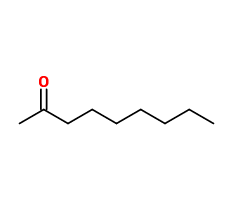
Photo credits: ScenTree SAS
Do you sell any of the raw materials? Would you like to let our users know?
Send an email to fournisseurs@scentree.coto learn about our advertising opportunities.
Do you sell any of the raw materials? Would you like to let our users know?
Send an email to fournisseurs@scentree.coto learn about our advertising opportunities.
General Presentation
-
CAS N° :
821-55-6 -
EINECS number :
212-480-0 -
FEMA number :
2785 -
FLAVIS number :
07.020
-
JECFA number :
292 -
Volatility :
Heart/Base -
Price Range :
€€€
Physico chemical properties
-
Appearance :
Colorless liquid -
Density :
0,82 -
Refractive Index @20°C :
1,418 – 1,423 -
Optical rotation :
Data not available. -
Vapor pressure :
Data not available. -
Flash Point :
79°C
-
Molecular formula :
C9H18O -
Molecular Weight :
142,24 g/mol -
Log P :
2,71 -
Fusion Point :
-21°C -
Boiling Point :
193°C -
Detection Threshold :
Donnée indisponible.
Chemistry & Uses
Uses in perfumery :
Year of discovery :
Data not available.
Natural availability :
Methyl Heptyl Ketone is present in fruits and spice such as banana, ginger, clove, coconut, tomato, corn, cheese, wine.. Thus, natural qualities are available
Isomerism :
Methyl Heptyl Ketone is the constitutional isomer of Cinnamaldehyde, although these two molecules do not smell the same.
Synthesis precursor :
A condensation of this ketone with another ketone may form the desired alkene. Hydrogenation of Methyl Heptyl Ketone can form 2-nonanol, also relevant in perfumery.
Synthesis route :
Methyl Heptyl Ketone can be synthesized by dry distillation of Barium Caprylate and Barium acetate at very low pressure (0.5 to 2 mmHg). Another method for synthesizing this compound is to use chromic acid, reacting with methyl heptyl carbinol at room temperature, to oxidize the latter.
Stability :
Stable in perfumes and in diverse bases.
Other comments :
Data not available.
Regulations & IFRA
Allergens :
This ingredient does not contain any allergen.
IFRA 51th :
This ingredient is not restricted for the 51th amendment

